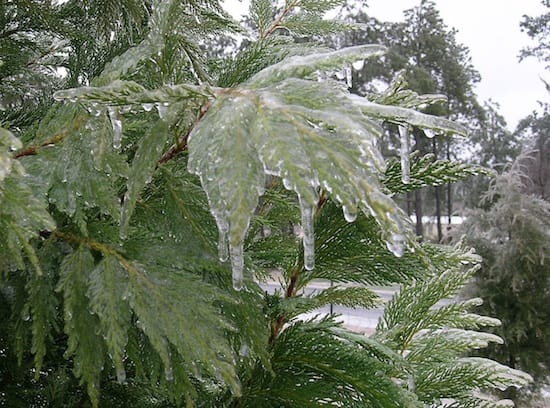Frank Watson is the University of Georgia Extension Agent in Wilkes County
Landscape plants get plenty of attention during the summer, but they need protection during Georgia’s winter months. Rather than trying to keep plants warm, gardeners should help protect plants from wind, snow, ice, drastic soil temperature changes and heat from the sun on cold days.
Reducing water loss can protect evergreen plants. All plants transpire, or lose, water through their leaves. Evergreens continue to lose water during the winter, so the plant’s roots must be able take up moisture.
Homeowners are more conscious of watering shrubs during the summer and often neglect to water plants during cold weather. Roots absorb moisture when it’s available, but during a dry period or even when the ground is frozen, moisture isn’t available. The plants continue to transpire water, drawing moisture from living cells. If too much water is released, the plant’s cells die, causing the plant’s leaves to turn brown and die.
High winds and warm sunshine on cold days result in a higher rate of water transpiration. Protection can be offered by relocating susceptible plants to a sheltered location. Also, provide them additional water during dry periods or prior to expected hard freezes.
An additional layer of mulch is also recommended during winter months after the first freeze. Mulch will reduce water loss from the soil, aid in transpiration and reduce “heaving” of the soil as the ground freezes and thaws. Soil heaving, or frost heaving, occurs when soil swells during freezing conditions and ice grows towards the soil’s surface.
To protect plants from cold damage, University of Georgia Extension horticulturists recommend following these six steps:
- Plant only varieties that are hardy for the area. Buy plants using the USDA hardiness zones.
- Given a choice, plant less-hardy plants in the highest part of the landscape. Cold air settles in the lowest area.
- Protect plants from cold wind with a fence or a tall evergreen hedge of trees or shrubs.
- Shade plants from direct winter sun, especially early morning sunshine. Plants that freeze slowly and thaw slowly will be damaged the least. The south side of the house, where there is no shade, is the worse place to plant tender plants.
- Stop feeding plants quickly available nitrogen in late summer to allow them to “harden off” before cold weather arrives.
- Plastic covering provides excellent protection. Build a frame over the plant or plants, cover them with plastic and secure the plastic to the ground with soil. Shade plastic to keep temperatures from building up inside. Plastic traps moisture and warm air as it radiates from the soil and blocks cold winds. Do not allow the plastic to touch plants.
For more information on how to care for ornamental plants in the winter, see the UGA circular Winter Protection of Ornamental Plants.
